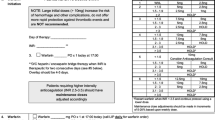Abstract
Many patients using warfarin are being managed in primary care and typically achieve a lower time in therapeutic range (TTR) for the international normalized ratio (INR) than patients in specialized care. A simple warfarin maintenance dosing tool could assist primary care physicians with improving TTR. We tested whether a simple warfarin maintenance dosing algorithm can improve TTR compared with usual care among Canadian primary care physicians. Primary care practices managing warfarin therapy without an anticoagulation clinic, computer decision support system or patient self-management tools enrolled 10–30 patients with target INR range 2–3. Practices were randomized to manage warfarin maintenance with the algorithm, or as usual in 2009–2010. Primary outcome was the mean individual patient TTR, and was compared between groups with adjustment for clustering within practices. There were 13 practices randomized to the Algorithm and 15 practices to Control, enrolling 240 and 297 patients respectively, with a mean follow-up of 280 days. Mean (standard deviation; SD) TTR before the study was comparable between groups [68 % (SD 26) for usual care vs. 70 % (SD 27) for the algorithm; p = 0.49]. Dosing decisions during the study in the algorithm group were more often in agreement with the algorithm’s recommendations than with usual care (81 vs. 91 %; p < 0.0001). Mean study TTR of the algorithm group was not superior to usual care: [72.1 (SE 1.7) vs. 71.4 % (SE 1.5) respectively; p = 0.73]. The simple warfarin maintenance dosing algorithm did not improve TTR compared with usual care among Canadian primary care practices.



Similar content being viewed by others
References
Holbrook A, Schulman S, Witt DM, Vandvik PO, Fish J, Kovacs MJ, Svensson PJ, Veenstra DL, Crowther M, Guyatt GH (2012) Evidence-based management of anticoagulant therapy: antithrombotic therapy and prevention of thrombosis, 9th ed: American College of Chest Physicians Evidence-Based Clinical Practice Guidelines. Chest 141:e152S–e184S. doi:10.1378/chest.11-2295
Wan Y, Heneghan C, Perera R, Roberts N, Hollowell J, Glasziou P, Bankhead C, Xu Y (2008) Anticoagulation control and prediction of adverse events in patients with atrial fibrillation: a systematic review. Circ Cardiovasc Qual Outcomes 1:84–91. doi:10.1161/CIRCOUTCOMES.108.796185
Nieuwlaat R, Connolly SJ, Mackay JA, Weise-Kelly L, Navarro T, Wilczynski NL, Brian HR (2011) Computerized clinical decision support systems for therapeutic drug monitoring and dosing: a decision-maker-researcher partnership systematic review. Implement Sci 6:90. doi:10.1186/1748-5908-6-90
van Walraven C, Jennings A, Oake N, Fergusson D, Forster AJ (2006) Effect of study setting on anticoagulation control: a systematic review and metaregression. Chest 129:1155–1166
Nieuwlaat R, Connolly B, Eikelboom J, Connolly S, Kaatz S (2010) Systematic review to identify validated manual warfarin maintenance dosing tools. Blood 116
Van Spall HG, Wallentin L, Yusuf S, Eikelboom JW, Nieuwlaat R, Yang S, Kabali C, Reilly PA, Ezekowitz MD, Connolly SJ (2012) Variation in warfarin dose adjustment practice is responsible for differences in the quality of anticoagulation control between centers and countries: an analysis of patients receiving warfarin in the randomized evaluation of long-term anticoagulation therapy (RE-LY) trial. Circulation 126:2309–2316. doi:10.1161/CIRCULATIONAHA.112.101808
Kim YK, Nieuwlaat R, Connolly SJ, Schulman S, Meijer K, Raju N, Kaatz S, Eikelboom JW (2010) Effect of a simple two-step warfarin dosing algorithm on anticoagulant control as measured by time in therapeutic range: a pilot study. J Thromb Haemost 8:101–106. doi:10.1111/j.1538-7836.2009.03652.x
Nieuwlaat R, Hubers LM, Spyropoulos AC, Eikelboom JW, Connolly BJ, Van Spall HG, Schulze KM, Cuddy SM, Stehouwer AC, Schulman S, Connolly SJ (2012) Randomised comparison of a simple warfarin dosing algorithm versus a computerised anticoagulation management system for control of warfarin maintenance therapy. Thromb Haemost 108:1228–1235. doi:10.1160/TH12-06-0433
Hylek EM, Go AS, Chang Y, Jensvold NG, Henault LE, Selby JV, Singer DE (2003) Effect of intensity of oral anticoagulation on stroke severity and mortality in atrial fibrillation. N Engl J Med 349:1019–1026
Rosendaal FR, Cannegieter SC, van der Meer FJ, Briet E (1993) A method to determine the optimal intensity of oral anticoagulant therapy. Thromb Haemost 69:236–239
Schulman S, Parpia S, Stewart C, Rudd-Scott L, Julian JA, Levine M (2011) Warfarin dose assessment every 4 weeks versus every 12 weeks in patients with stable international normalized ratios: a randomized trial. Ann Intern Med 155:653–659. doi:10.1059/0003-4819-155-10-201111150-00003
Connolly SJ, Ezekowitz MD, Yusuf S, Eikelboom J, Oldgren J, Parekh A, Pogue J, Reilly PA, Themeles E, Varrone J, Wang S, Alings M, Xavier D, Zhu J, Diaz R, Lewis BS, Darius H, Diener HC, Joyner CD, Wallentin L (2009) Dabigatran versus warfarin in patients with atrial fibrillation. N Engl J Med 361:1139–1151. doi:10.1056/NEJMoa0905561
Donner A, Klar N (2000) Design and analysis of cluster randomization trials in health research. Arnold Publishers, London
Acknowledgments
We thank Gayle Lewis and Heather Beresh for coordinating the study. Research funding grants were received for the study from the Canadian Network and Centre for Trials Internationally (CANNeCTIN) and the Hamilton Academic Health Sciences Organization (HAHSO) alternative Funding Plan (AFP) Innovation Fund. During the preparation and execution phase of the study, RN was supported by a Rubicon post-doctoral research grant from the Netherlands Organization for Scientific Research (NWO), and LMH was supported by a student research grant from the Netherlands Heart Foundation.
Conflict of interest
None declared.
Author information
Authors and Affiliations
Corresponding author
Electronic supplementary material
Below is the link to the electronic supplementary material.
Rights and permissions
About this article
Cite this article
Nieuwlaat, R., Eikelboom, J.W., Schulman, S. et al. Cluster randomized controlled trial of a simple warfarin maintenance dosing algorithm versus usual care among primary care practices. J Thromb Thrombolysis 37, 435–442 (2014). https://doi.org/10.1007/s11239-013-0969-x
Published:
Issue Date:
DOI: https://doi.org/10.1007/s11239-013-0969-x




